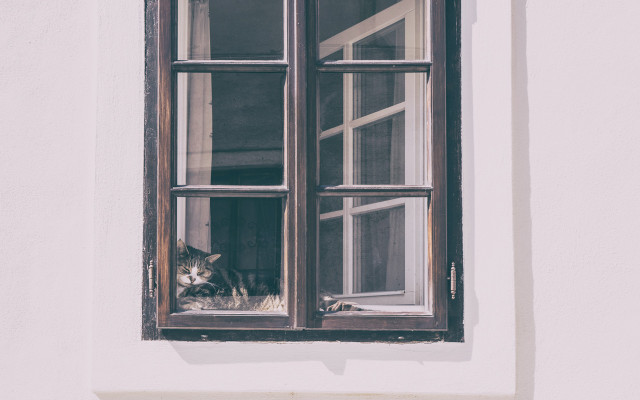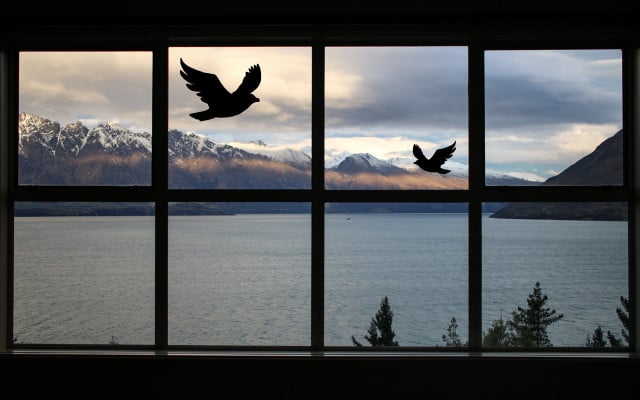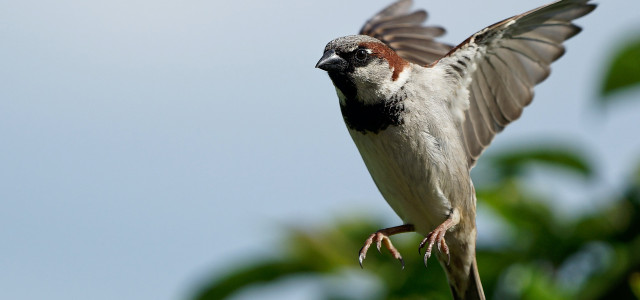The saddest part about a bird flying into your window is that it’s completely avoidable. We’ll show you how to make your windows bird-safe.
From sparrows to starlings, numerous species of birds – including endangered ones – meet their untimely demise by flying into windows. The problem isn’t an uncontrollable epidemic or a rare disease, it’s an anthropogenic threat – or one of our own creation. We are responsible when birds fly into windows.
And we aren’t talking about just a handful of birds. According to a 2014 study conducted by Smithsonian researchers, every year an estimated 599 million birds die from flying into windows in the U.S. alone. This is the second greatest anthropogenic contributor to bird mortality behind feral and free ranging cats.
Window collision deaths involve birds flying into glass panes with full force. Sometimes they recover after a short period of dizziness. Significantly more often, however, the injuries are so severe that the birds die of internal bleeding either immediately or only a little while later. Birds “lucky” enough to have survived flying into a window are also left more vulnerable and are easy prey for predators.
Why Birds Fly into Windows

The problem with glass pane windows is that birds don’t usually perceive them as an obstacle. Plus, they pose even more of a threat when sparkly clean. Birds see a window and assume that there is a large passageway at the location and fly towards it.
Reflective glass is equally as deadly. This poses an even greater risk if the window is located opposite trees or bushes. Reflections of familiar surroundings trick the birds into thinking they’re headed somewhere they’re not.
Additional threats to bird safety are windows illuminated from the inside. The higher brightly lit windows are located, the more dangerous they can be. Birds are attracted to light and unknowingly fly to their death.
In short: Birds flying into glass windows is a serious problem. The cleaner your windows are, the greater the risk these pose to these airborne animals.
How to Make Your Windows Bird-Safe



The simplest solution to preventing birds from flying into windows is cleaning your windows far less often. However, there are of course a number of more effective options out there.
A relatively inexpensive method to avoiding collision casualties is so-called “bird tape“. These are semi-transparent adhesive tapes you can attach to your window to ward off any birds flying in the area. However, it’s particularly important to limit the distances between the individual strips. Particularly small birds will otherwise try to fly through the gaps.
The Humane Society of the United States recommends the following bird-proofing methods for your windows with strips of chart tape on the outside of the window:
- 1/4″ vertical white strips spaced 4″ apart
- 1/8″ horizontal black strips spaced 1″ apart
Additional inexpensive and effective methods of preventing birds from flying into windows are vertical blinds, shades and curtains. The rule of thumb here is: When not enjoying the view or when you don’t need natural light, keep them closed. If you don’t want to hang them on the windows, artistically applied patterns or stickers may be an option.
Black Bird Stickers Don’t Work



One of the more common bird safety-proofing measures out there is adding black colored stickers of birds to your window. However widespread, this method isn’t exactly as effective as we may assume.
BirdLife International highlights a couple of strategic shortcomings associated with these familiar flocks of stationary black silhouettes. Here’s what you should consider before buying stickers:
- Black stickers aren’t visible enough: Windows often look dark from the outside and black silhouettes don’t create enough visible contrast.
- Only one is not enough: As outlined above, birds are capable of flying through relatively small passageways. Black bird stickers placed more than 4-6″ apart won’t prevent birds from flying into windows.
If semi-permanent bird tape isn’t your first choice and you’ve decided for decorative bird stickers instead, bird sticker quantity and visibility are key. BirdLife International suggests lining your window with orange and yellow bird stickers instead of black ones. Colored stickers in hand, be sure to apply these to the outside of the window as they’re more effective at breaking up reflections.
Renovation and Building Tips: How to Help Animals
You do not want to glue stickers on your windows? There is another option to keep birds from flying into them:
When building a new house or replacing windows, it may be worthwhile to consider glass options with a UV-reflective coating. There are markings on these which are only visible in the UV light range. Most native birds (but not all) can make these out. If you are considering buying such windows, you should definitely talk to experts in advance to make sure you’re making the best investment possible.
By Kira Welling
This article was translated from German to English by Evan Binford. You can view the original here: Vogelschutz am Fenster: So verhinderst du Vogelschlag.
** Links to retailers marked with ** or underlined orange are partially partner links: If you buy here, you actively support Utopia.org, because we will receive a small part of the sales proceeds. More info.Do you like this post?







